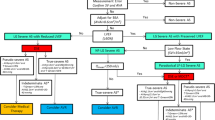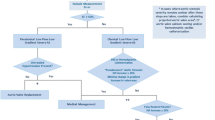Opinion statement
Low gradient aortic stenosis can be caused by critical aortic stenosis causing left ventricular impairment or by more moderate aortic stenosis coexisting with another cause of left ventricular impairment. The main challenges are to differentiate these two states and then to determine whether the left ventricle is likely to recover after aortic valve surgery. Exhaustive echocardiography is necessary, including the use of dobutamine stress. Guideline criteria for severe aortic stenosis are given in this article. The most secure criteria are mean transaortic pressure difference greater than 30 mm Hg and effective orifice area less than 1.2 cm2 during dobutamine stress. However, the presence of left ventricular contractile reserve more closely determines outcome after surgery than do markers of stenosis. Surgery is most clearly indicated if there is severe aortic stenosis and an increase in the systolic velocity integral by greater than 20% during dobutamine infusion. Preoperative catheterization is necessary to determine coronary anatomy, but the aortic valve should not be crossed because of the relatively high risk of death, stroke, pulmonary edema, and cardiogenic shock. In patients judged too ill for immediate surgery, a period of medical resuscitation with diuretics and dobutamine should be considered. Balloon valvotomy is not indicated.
Similar content being viewed by others
References and Recommended Reading
Lindroos M, Kupari M, Heikkila J, Tilvis R: Prevalence of aortic valve abnormalities in the elderly: an echocardiographic study of a random population sample. J Am Coll Cardiol 1993, 21:1220–1225.
Horstkotte D, Loogen F: The natural history of aortic valve stenosis. Eur Heart J 1988, 9(suppl E):57–64.
ACC/AHA guidelines for the management of patients with valvular heart disease. A report of the American College of Cardiology/American Heart Association. Task Force on Practice Guidelines (Committee on Management of Patients with Valvular Heart Disease) [no authors listed]. J Am Coll Cardiol 1998, 32:1486–1588.
Carabello BA: Aortic stenosis. N Engl J Med 2002, 346:677–682.
Chambers J, Das P: Exercise testing in aortic stenosis. Heart 2001, 86:361–362.
Schwartz E, Baumann P, Manthey J, et al.: The effect of aortic valve replacement on survival. Circulation 1982, 66:1105–1110.
Connolly HM, Oh JK, Orszulak TA, et al.: Aortic valve replacement for aortic stenosis with severe left ventricular dysfunction. Prognostic indicators. Circulation 1997, 95:2395–2400.
Sasayama S, Ross J, Franklin D, et al.: Adaptations of the left ventricle to chronic pressure overload. Circ Res 1976, 38:172–178.
Carabello BA, Green LH, Grossman W, et al.: Hemodynamic determinants of prognosis of aortic valve replacement in critical aortic stenosis and advanced congestive heart failure. Circulation 1980, 62:42–48.
Cannon JR, Zile MR, Crawford FA, et al.: Aortic valve resistance as an adjunct to the Gorlin formula in assessing the severity of aortic stenosis in symptomatic patients. J Am Coll Cardiol 1992, 20:1517–1523.
Scwammenthal E, Vered Z, Moshkowitz Y, et al.: Dobutamine echocardiography in patients with aortic stenosis and left ventricular dysfunction: predicting outcome as a function of management strategy. Chest 2001, 119:1766–1777.
Monin J, Monchi M, Gest V, et al.: Aortic stenosis with severe left ventricular dysfunction and low transvalvular pressure gradients. Risk stratification by low-dose dobutamine echocardiography. J Am Coll Cardiol 2001, 37:2101–2107. This together with reference 13 provides the main clinical evidence for managing patients with low gradient, low ejection fraction aortic stenosis.
Nishimura RA, Grantham JA, Connolly HM, et al.: Low-output, low-gradient aortic stenosis in patients with depressed left ventricular systolic function: the clinical utility of the dobutamine challenge in the catheterization laboratory. Circulation 2002, 106:809–813.
Zoghbi WA, Galon A, Quinones MA: Accurate assessment of aortic stenosis severity by Doppler echocardiography independent of aortic jet velocity. Am Heart J 1988, 116:855–863.
Cook RA, Chambers J: The peak to mean pressure gradient ratio: a new method of grading aortic stenosis. Heart 1998, 80(suppl):S36.
Lewis RP, Rittigers SE, Forester WF, et al.: A critical review of systolic time interval. Circulation 1977, 56:146–158.
Bruch C, Schermund A, Dagres N, et al.: Severe aortic valve stenosis with preserved and reduced systolic left ventricular function: diagnostic usefulness of the Tei index. J Am Soc Echocardiogr 2002, 15:869–876.
Takeda S, Rimington H, Chambers J: The relationship between transaortic pressure difference and flow during dobutamine stress echocardiography in patients with aortic stenosis. Heart 1999, 82:11–14.
Burwash IG, Thomas DD, Sadahiro M, et al.: Dependence of Gorlin formula and continuity equation valve areas on transvalvular volume flow rate in valvular aortic stenosis. Circulation 1994, 89:827–835.
Das P, Rimington H, Smeeton N, Chambers J: Determinants of symptoms and exercise capacity in aortic stenosis: a comparison of resting haemodynamics and valve compliance during dobutamine stress. Eur Heart J 2003, 24:1254–1263.
De Fillipi CR, Peeler RG, Roehill WH: Relationships between left ventricular ejection time, stroke volume and heart rate in normal individuals and patients with cardiovascular disease. Am Heart J 1995, 75:191–194.
Malouf JF, Enriquez-Sarano M, Pellikka PA, et al.: Severe pulmonary hypertension in patients with severe aortic valve stenosis: clinical profile and prognostic implications. J Am Coll Cardiol 2002, 40:789–795.
Folland ED, Oprian C, Giacomini J, et al.: Complications of cardiac catheterization and angiography in patients with valvular heart disease: VA cooperative study on valvular heart disease. Cathet Cardiovasc Diagn 1989, 17:15–21.
Roger VL, Tajik AJ, Reeder GS, et al.: Effect of Doppler echocardiography on utilization of hemodynamic cardiac catheterization in the preoperative evaluation of aortic stenosis. Mayo Clinic Proc 1996, 71:141–149.
Omran H, Schmidt H, Hackenbroch M, et al.: Silent and apparent cerebral embolism after retrograde catheterisation of the aortic valve in valvular stenosis: a prospective, randomised study. Lancet 2003, 361:1241–1246. A carefully constructed prospective study showing a high rate of silent and overt cerebral infarcts after retrograde left ventricular catheterization for aortic stenosis. This provides further evidence that catheterization should be confined to coronary angiography in these patients.
Khot UN, Novaro GM, Popovic ZB, et al.: Nitroprusside in critically ill patients with left ventricular dysfunction and aortic stenosis. N Engl J Med 2003, 348:1756–1763. A recent study confirming earlier work that careful afterload reduction may be effective in patients in heart failure even in the presence of apparently critical aortic stenosis. This challenges the dogma that arterial dilators are absolutely contraindicated in severe aortic stenosis.
Safian RD, Warren SE, Berman AD, et al.: Improvement of symptoms and left ventricular performance after balloon aortic valvuloplasty in patients with aortic stenosis and depressed left ventricular ejection fraction. Circulation 1988, 78:1181–1191.
Author information
Authors and Affiliations
Rights and permissions
About this article
Cite this article
Chambers, J. Low gradient, low ejection fraction aortic stenosis. Curr Treat Options Cardio Med 5, 469–474 (2003). https://doi.org/10.1007/s11936-003-0036-6
Issue Date:
DOI: https://doi.org/10.1007/s11936-003-0036-6




